Carpets in the living room: varieties, choices, examples
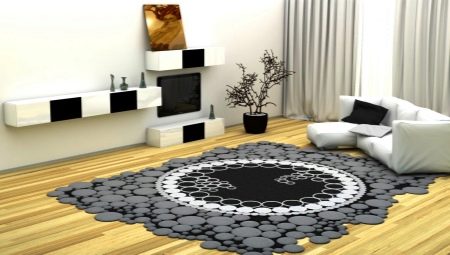
Do you need a carpet in the living room? This is a rhetorical question. Of course, it is necessary, because coziness and comfort in every apartment is an urgent need. At the same time, they usually spread it on the floor, since wall options have long become archaic.
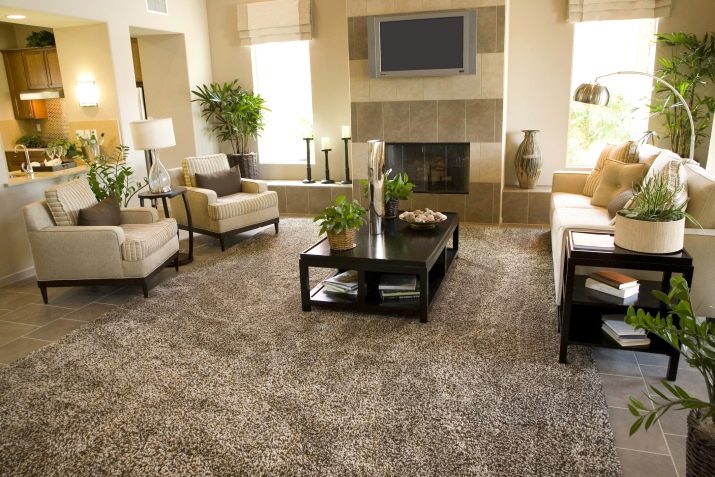
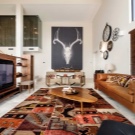
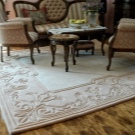
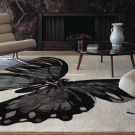
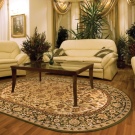
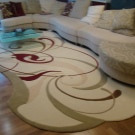
Appointment
In the interior of the living room, a well-chosen carpet performs several relevant functions:
- the carpet is needed to give the room coziness and comfort;
- with the placement of the carpet, the room takes on a complete look;
- on dark carpets, dirt is less noticeable, you do not need to sweep and vacuum the floor every day;
- the carpet on the floor is an excellent sound insulator;
- in cool weather, the carpet will not only warm the room, but also contribute to the normalization of the humidity level;
- woolen carpets are good for the feet, as they promote a gentle massage of the feet when walking on them. This normalizes blood pressure and increases the tone of the body.

Shapes and sizes
The sizes of coverings for halls are divided into 3 types:
- small - an area of up to 3 m2, with dimensions of 0.6x1.1 m, 0.8x1.5 m, 1x2 m, 1.5x2 m;
- average - 3-6 m2, with standard dimensions 2x3 m, 1.5x2.05 m;
- large - 6 m2 and more, with dimensions of 2x3.5 m, 2x4 m, 2.5x4 m, 3x4 m, 3x5 m.
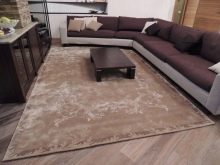
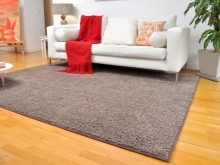
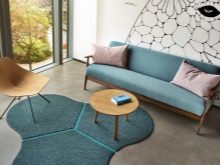
Small carpets are usually used as accessories to tastefully add color accents, for example, around a fireplace. These rugs are available in a wide variety of colors.
Small rugs are great for spatial zoning of rooms.
Large coatings are too much of an emphasis on themselves, therefore in bright interiors, monochromatic coatings are used. When there is little furniture with high legs in the living room, carpets of considerable size fit perfectly there.
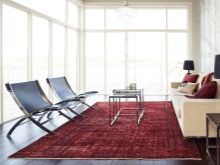
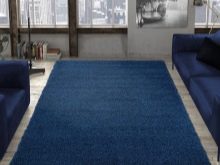
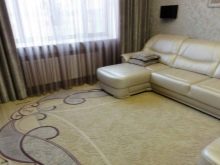
It is easy to determine the parameters of the coatings - the necessary contours are laid out with a bright tape as a marking, then the most suitable options are evaluated.
When arranging furniture elements in the living room around the perimeter or in the case of a square shape of the living room, it is allowed to cut the carpets to the required size. It is important to remember that most often carpets have a typical width of up to 3.6 m, and any length. It follows from this that coatings with one side of more than 3.6 m cannot be obtained.
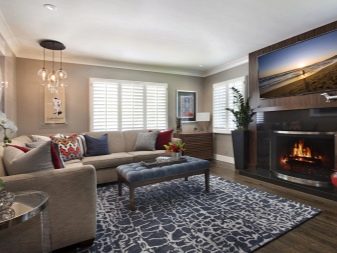
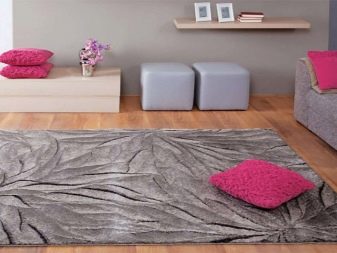

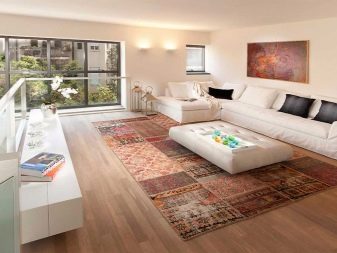
Materials (edit)
Since ancient times, for the production of coatings have been used wool, silk. Nowadays, goods are used as raw materials, for the creation of which it is used artificial raw materials (polypropylene, viscose, etc.).
Woolen carpets are expensive products made from the strong and soft wool of sheep. The pile of wool coatings is elastic and non-flammable. Such carpets look presentable. Their service life reaches 50 years.
Their disadvantages are their rapid contamination, as well as susceptibility to moths and mold. It is for this reason that carpet fibers are impregnated with special protective compounds.
Wool fibers, in comparison with synthetic counterparts, absorb dyes to a lesser extent, therefore, wool carpets usually have calmer colors.
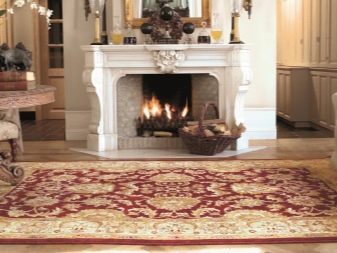
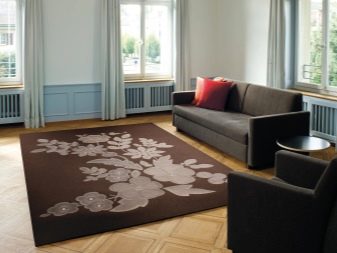
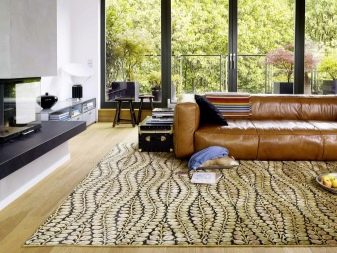

At the same time, the resulting color fade little, retaining freshness and contrast for a long time. Synthetic products fade much faster.
Silk is based on natural fibers created by silkworms. Silk products are more expensive than woolen carpets, but they are much stronger, have a special sheen of the pile and are delicate to the touch. The elasticity of silk threads contributes to the delicate and skillful elaboration of patterns. Some items in the hands of craftsmen become unique works of art. Silk finishes will fade and shed during the wash process.
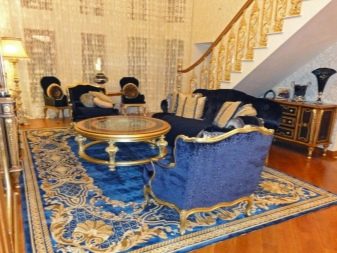
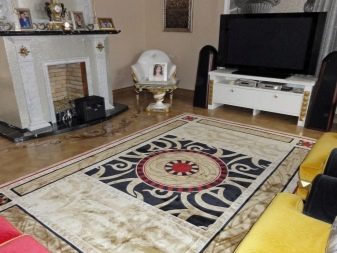
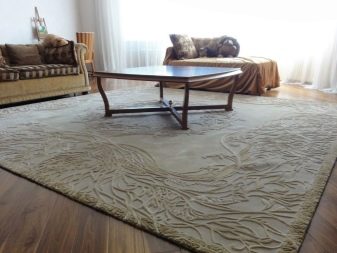
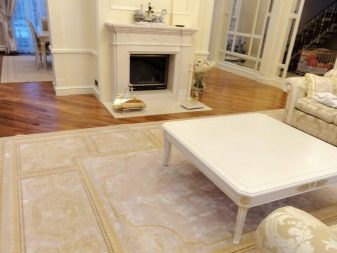
Viscose is a man-made fiber, but it is obtained from spruce or pine pulp. Therefore, products made from this material often become a good replacement for coatings made from natural materials. Outwardly, viscose resembles silk, hence its common name - "artificial silk".
Viscose threads are well dyed, which contributes to the creation of beautiful canvases with an unobtrusive shine, keeping the original tone for a long time.
Products are wear-resistant, do not electrify, do not wrinkle and are successfully used in walk-through rooms. Their disadvantages include the ability to absorb moisture and the loss of strength as a result.
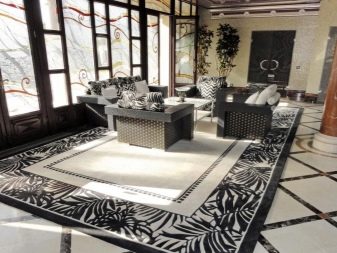
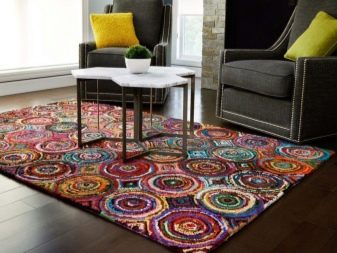
A high level of thermal conductivity is a characteristic feature of natural cotton fiber carpets. In addition, they absorb moisture well and breathe well. Cotton does not pose a danger to allergy sufferers, and goods made from it are classified as budget purchases. Among their shortcomings, it is necessary to indicate a predisposition to deformation, shrinkage and a low level of elasticity.
From knitted yarn in the form of a ribbon, made of pure cotton, bright carpets are produced, with the help of which you can profitably revitalize any thematic area in the hall.
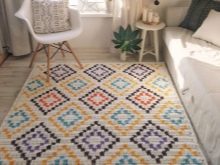
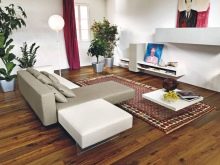
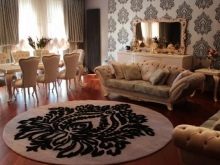
Jute is a type of shrub plant, which includes linden trees. Jute products are durable and inexpensive, but sensitive to water (prone to shrinkage).
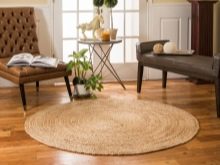
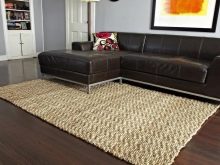
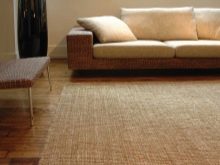
Polyamide is a synthetic popular in the manufacture of flooring products. Strength, contrasting patterns, excellent fire-fighting qualities, elasticity and elegance are their main qualities.
Polyamide carpets are wear-resistant and do not lose their shape, wash well and dry quickly. At the same time, they are prone to fading and become electrified.
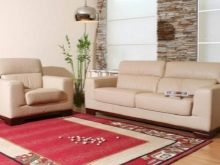
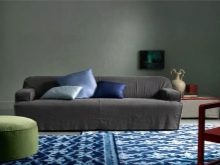
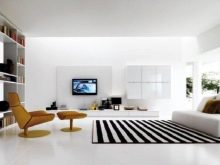
Polypropylene fabrics are unpretentious in maintenance, since the thread of the material is smooth. The coatings are dense, preventing the penetration of dust and dirt. A vacuum cleaner is sufficient to take care of the product. These carpets are not very durable - they last 4-5 years, after which they lose their presentation and look not entirely presentable.
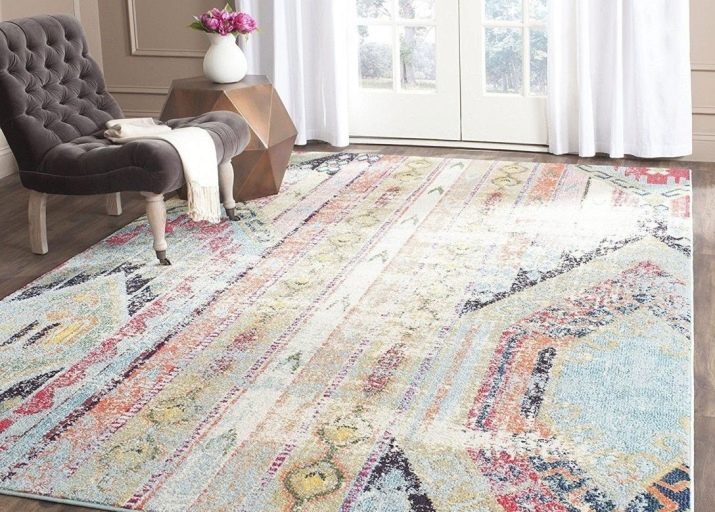
One of the types of polypropylene is considered devoid of these shortcomings - hit set, treated with anti-mud and antiseptic compounds. Carpets made of it are durable, lightweight and wear little. The material is antistatic, elastic, but burns.
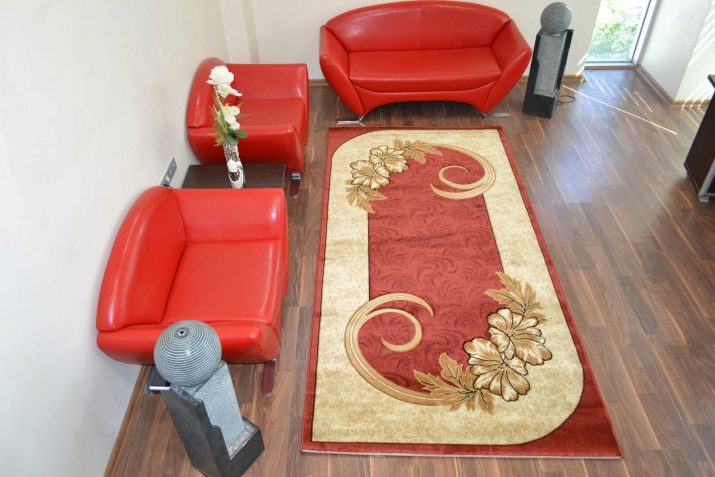
Polyester carpets outwardly resemble woolen ones (originally conceived as an analogue of woolen ones), they are durable and soft, wrinkle little, do not fade, fire-resistant, dry quickly and clean well.
Among the disadvantages is the high electrification of the material.


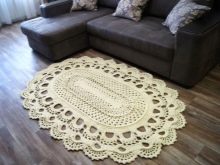
Lint-free carpet is very popular nowadays, for the manufacture of which cotton, jute, linen, bamboo material and even seaweed are used. Such carpets are in demand because they have a whole list of advantages:
- the absence of lint and the dense structure of the fabric do not allow particles of dust and dirt to penetrate into the carpet, which greatly facilitates the process of cleaning;
- safety and durability with a minimum degree of deformation;
- the widest selection of color and stylistic options suitable for various interiors.
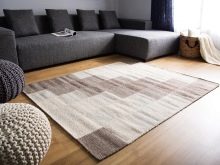
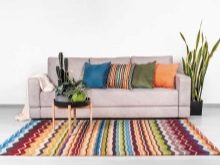
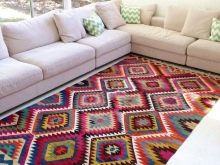
Color spectrum
The most important factor in choosing a carpet is color. For a well-lit living room with south-facing windows, they are suitable coatings of cold colors (light, blue and the like.) If the room is not so bright, then its interior should be "warmed" products of warm colors. The advantages of monochromatic products include their ability to favorably highlight the shades and configuration of furniture.
The design rule is that the basic color of the carpet should not be the same color as the floors. For example, if the floor is burgundy, brown, dark gray or dark red, then the tone of the carpet should play on the contrast "light-dark". Otherwise, vision will get tired from the excessive presence of dark tones.
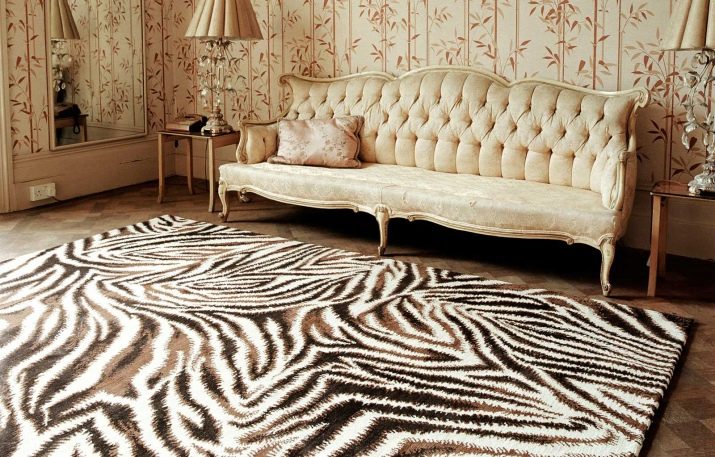
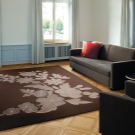
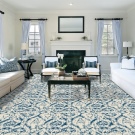
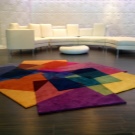
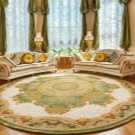

Nowadays, the trend is to use faded carpets for halls that imitate wear, which look great in interiors with antique furniture elements.
Modernity is characterized by great severity. it is more optimal for him to select coatings of the same tone. Products with drawings in beige and brown tones will harmoniously fit into the halls designed in eastern directions.
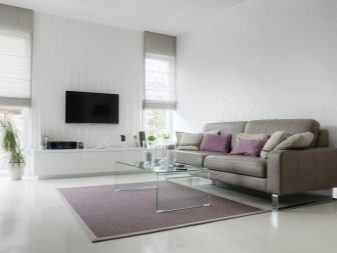

Style solution
Such modern styles as, for example, shabby chic (“shabby chic”), retro, Provence, country, often involve the use of carpets with faded tones (aged prints).
Today, products made in the spirit of feng shui are widespread, creating a favorable indoor climate. Here, interior elements are located in strictly defined places, and each color has its own meaning.
- According to Eastern philosophy, red and brown tones have a positive effect on the energy of the home and symbolize well-being in the home.
- Fluffy coatings bring peace and happiness to your home.
- Preference is given to natural materials.
- For halls, rounded shapes are preferable, symbolizing spirituality and peacefulness. Rectangular carpets stimulate intellectual work, and therefore they are spread in offices.
- According to feng shui, it is not recommended to abuse the number of coatings, as well as their large sizes. This leads to unnecessary energy costs.
- Do not spread carpets on dirty or defective surfaces, as the floor is the foundation of your home.
- To neutralize the negative energy collected by the carpet, it is recommended to "salt" it a little and sprinkle with herbs that take away the negative.

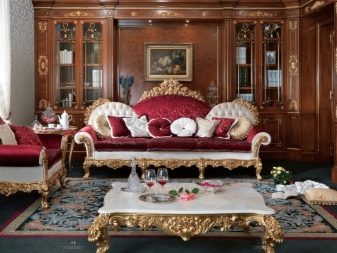
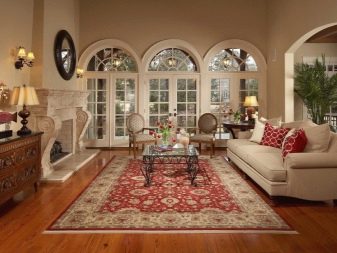
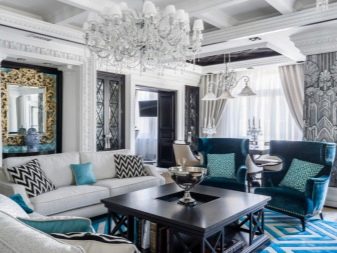
In general, this design is environmentally friendly, harmonious and comfortable, but not entirely practical, since it uses products with elongated pile.
Classic options the interiors of the hall suggest the use of carpets with chic baroque ornamental designs or floral designs. If the colors of the hall are closer to the modern direction, then for the decor they take monophonic carpets decorated with patterns in restrained and strict colors. Alternatively, they can be avant-garde symbols.For rooms with antique furniture, faded coverings will be an excellent solution.

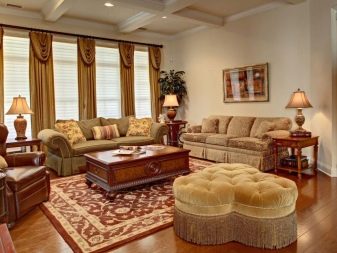
Although the style high tech somewhat austere, in the halls made according to this direction, monochromatic coverings of predominantly cold tones can be placed.
Patterns should be laconic and clear, containing regular geometric shapes.
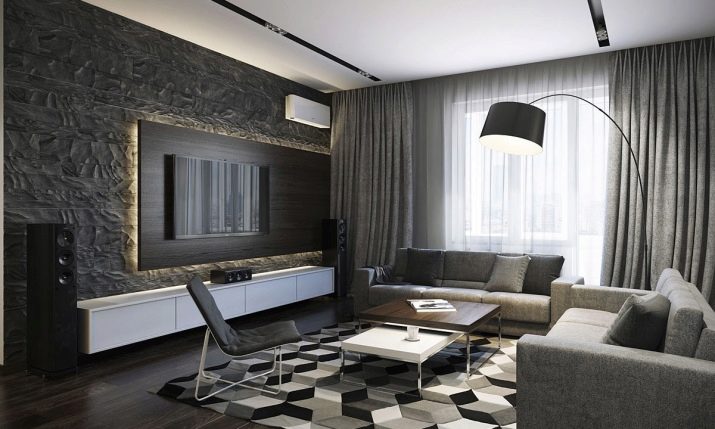
In halls with decor in the style of the usual country more often multi-colored and rough coatings are used, often homemade.
Homemade rugs have changed a lot over the past decades and have adapted to a large extent to modern styles. After all, weaving an original carpet is easy. But even today the so-called "grandmother's" rugs, woven from multi-colored fabric strips, are quite suitable. These rugs gravitate towards the country style.
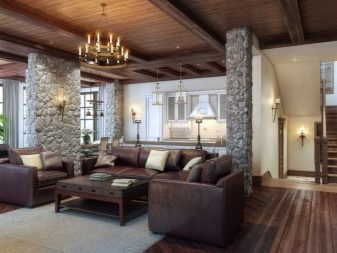

American carpets, differing from the "grandmother's" in the way of weaving, they look extremely presentable in the halls. Often, such coatings are made from several small fragments. These patterns are often a decoration for newfangled decor styles.
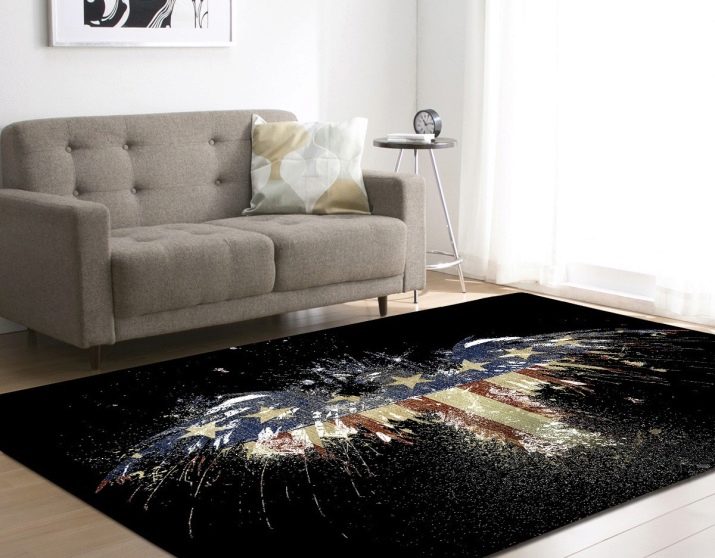
Manufacturers overview
Of course, handicrafts are still the best today. In some cases, they are real works of art.
Nonetheless, factory-made carpets produced in some countries are not inferior in quality to handmade products.
In this context, the most popular are the coatings made in the following countries.
- Iran. For several thousand years, Iranian craftsmen have been leading the carpet business. Excellent handmade carpets are purchased in Iran.
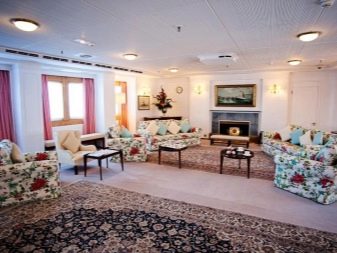
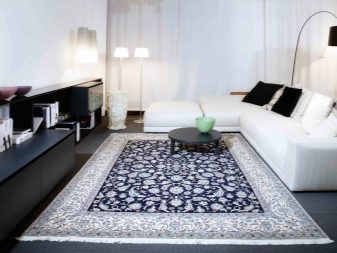
- India... In this country, manual labor, as before, is widespread. An example is the workshops of Jaipur - the largest company in the country has been producing silk carpets by hand for more than 17 years. The company employs about 40,000 craftsmen working for the company in 600 villages across the country.
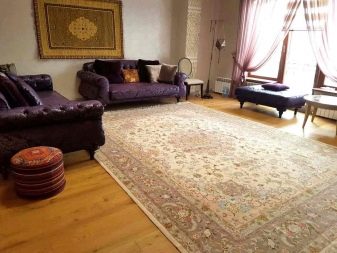
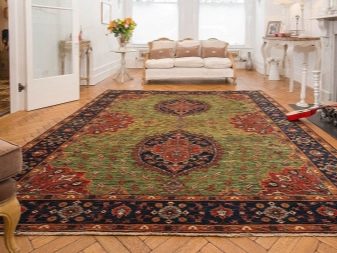
- Belgium. Carpet weaving has successfully taken root in Western European countries. In Belgium, quality carpets are produced by machine. In the process of work, expensive and high quality New Zealand wool is used.
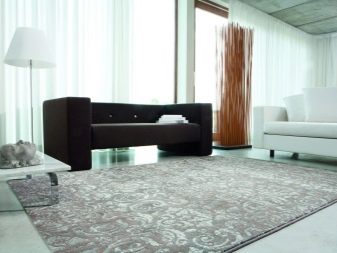
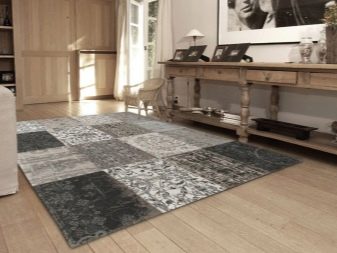
- Turkey. The Turkish carpet has been famous for a long time. Despite the fact that the country switched to machine production a long time ago, the quality of products did not suffer from this at all.

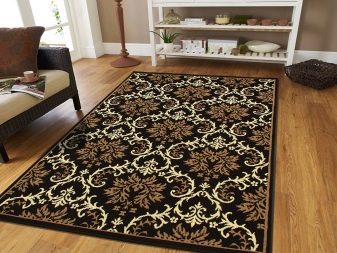
- Nepal. The country is known for the production of excellent handmade yak wool carpets.
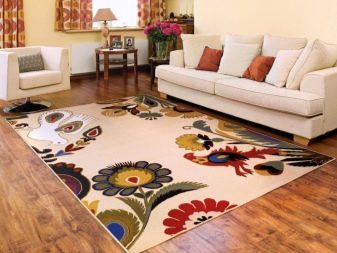
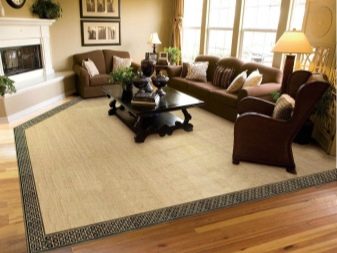
Of the companies producing quality carpets, one can single out:
- Turkish company Mega, featuring the production of Heatset polypropylene fibers. They are characterized by high indicators of quality, strength, durability. The feeling of this fabric canvases are soft, pleasant, outwardly reminiscent of wool.
In production, they use heat setting - the technology of twisting fibers into a bundle. Carpets are sold at a budgetary cost.
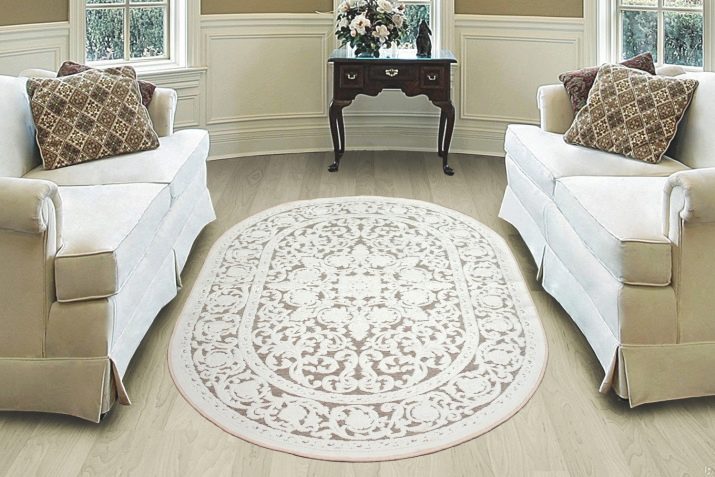
- Oriental Is an Egyptian firm that produces excellent and environmentally friendly polypropylene coatings that imitate wool. Products are processed with anti-fire, anti-mud, anti-static and anti-mole compounds.
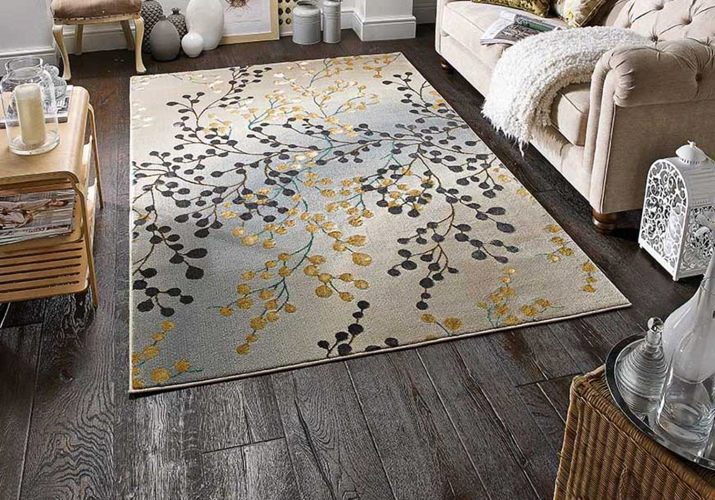
- Valencia Is a Russian company that combines classics and newfangled trends in production. The assortment is based on models made of artificial and mixed fibers (viscose, acrylic, hit-set). Jute and frieze are used for lining.

How to choose?
It will be easier to choose the right fashionable carpet for the hall if you have decided on the style of the interior in the apartment as a whole and in the living room in particular.
From a practical point of view, the palace is not very suitable for the living room: firstly, it is much thinner than a standard carpet, that is, it is less durable; secondly, the carpets do not have soundproofing qualities and are not so soft.
In the bright room, preference is given to carpets in cold colors. A dark living room will be refreshed by warm, moderate tones. Emphasizing the beauty of furniture, you should choose monochromatic products. A rug with patterns will distract attention from the interior.
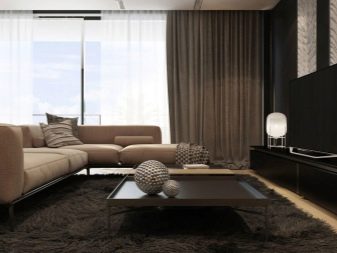
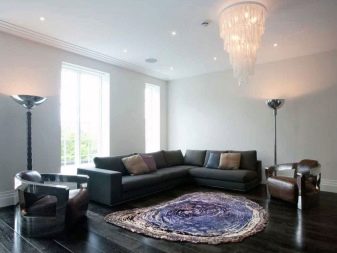
When choosing a shade of coverage, it will be useful to think about practicality.So, the white carpet will soon get dirty if the room is a walk-through.
With the dominance of neutral shades in it, you can diversify the overall color using the effect of contrast, while creating a harmonious color pair.
So, the red covering in a bright living room should be emphasized with pillows of similar shades or with the corresponding patterns on the curtains. When choosing a carpet product for a bright room, it is important to decide what impression the interior will form - in muted and relaxing colors or in defiant ones.

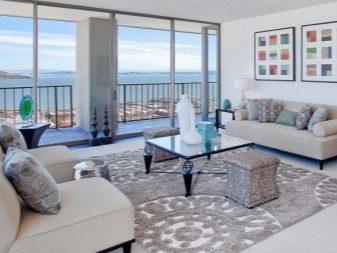
A number of tips will help you decide on a purchase.
- Slightly "worn" models of carpets are suitable for interiors with antique furniture.
- Classic interiors go well with French-style finishes.
- Modern options require restraint and rigor. Coatings with the correct geometry or avant-garde elements will be appropriate here.
- Beige and brown are used in oriental styles.
- Small-sized coverings will decorate individual areas: in front of a sleeping place, a fireplace, in a children's corner.
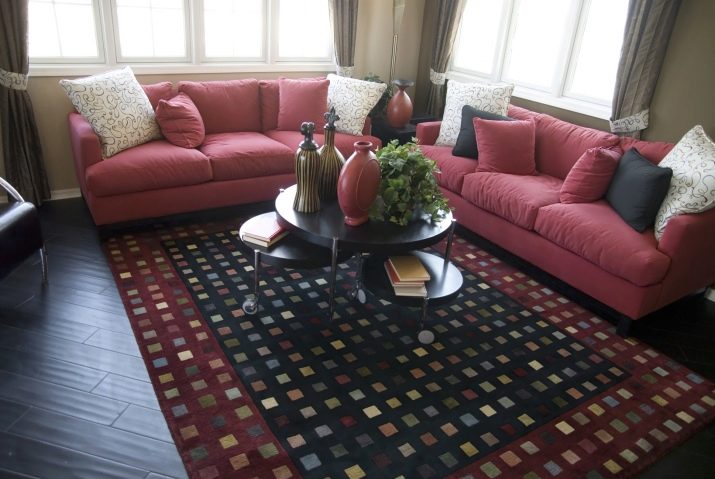
The shape of the carpets should also be taken into account.
- Circle - versatile option, suitable for different places. Looks spectacular under the coffee table in the halls.

- Octagon versatile and can be combined with any premises.
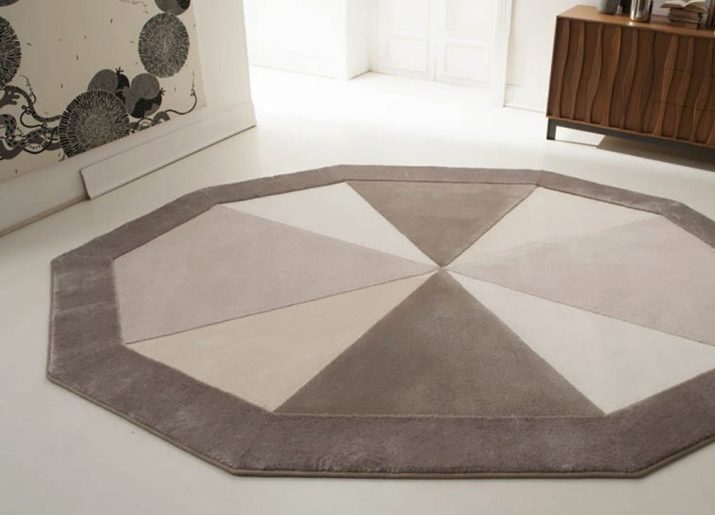
- Products oval commonly used in kitchens.
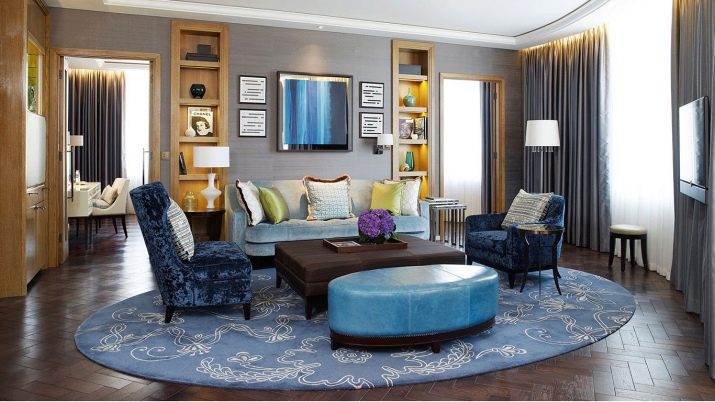
- Square shapes well combined with rooms of the correct geometric shape.
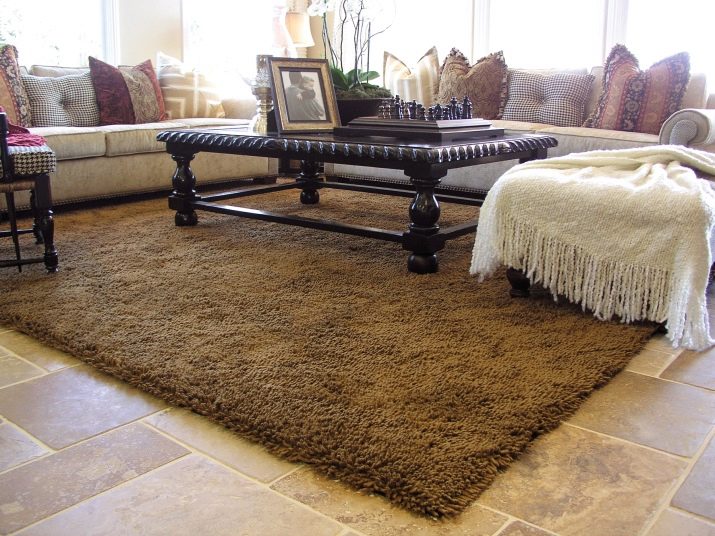
In addition, the shape of the selected coatings depends on the furniture elements to be filled in the hall and the characteristics of the decorative load in it.
If straight contours dominate in the hall, then it is more logical to spread a round covering on the floors to level out angularities. At the same time, a couple of similarly shaped additions are often added to the hall - pillows for sofas, vases or wall decorations.
The oval products in the hall fit perfectly into the classics of the interiors. If you do not intend to use rounded elements, then you should choose a rectangular shape. Most often this is done in a minimalist style.
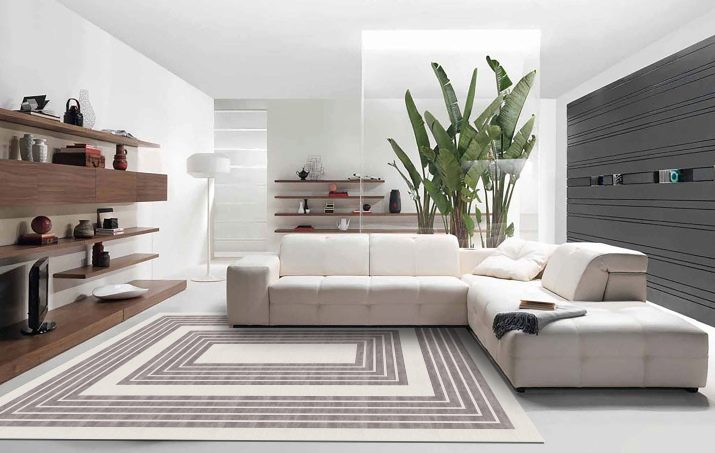
It is important to remember that carpets differ both in the length of the pile and in its structure, which depends on the specifics of the technologies used.
The most practical are carpets with a strong base - woven, wicker, knitted, since their durability depends on this factor.
When choosing models for the hall, it is important to know a lot about the length and structure of the pile. It is worth remembering that traces of shoes and other objects lying on it are imprinted on the velor, this is a very capricious surface. For living rooms, in terms of practicality, coverings where the villi are woven using the frieze, saxony or boucle method are quite suitable.
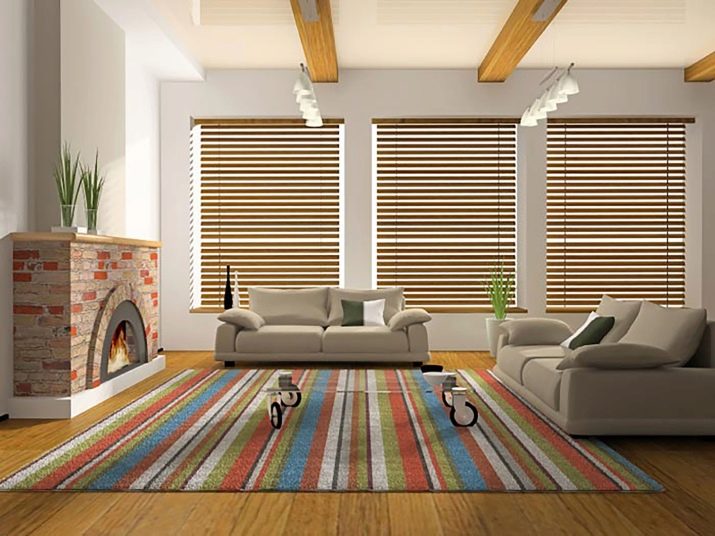
How to make a bed?
For an unmistakable arrangement of coatings in the hall, special markings are used, highlighting the contours of their future placement with colored tape. This takes into account a number of aspects. The carpets in the rooms are matched with the arrangement of the sofa group of elements in three versions.
- Coverings are located near sofas and armchairs, without going under them. The distance between the edge of the carpet and the furniture should allow for free legs on the carpet for people sitting on the couch. In the central part of the cover, a table for magazines can be placed.
- The covering goes under the sofa up to half of the last. In this case of placement, this zone appears to be visually significant in the hall.
- In the spacious rooms, a generous carpet covers the entire furniture area.
- The choice of the placement of carpets depends on the interior, taste and creative ideas of the owners of the dwelling.
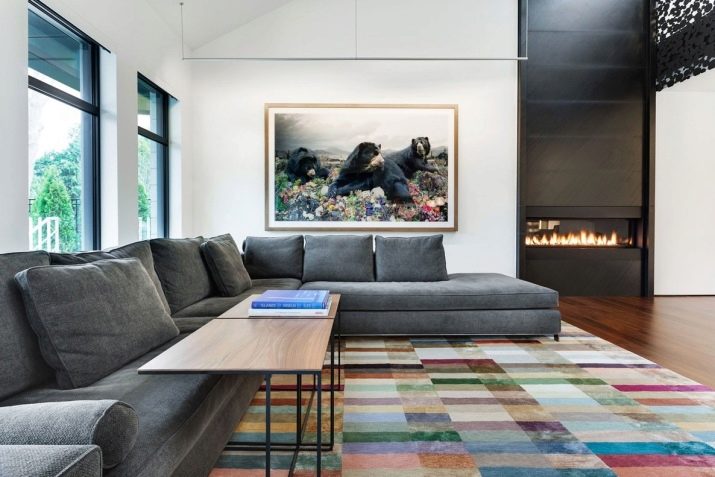
Beautiful ideas
Below are some stylish ideas for using carpets in the halls.

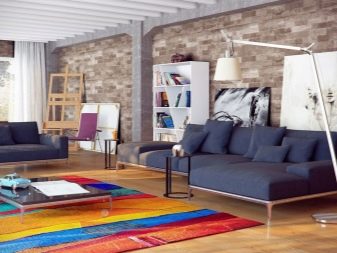
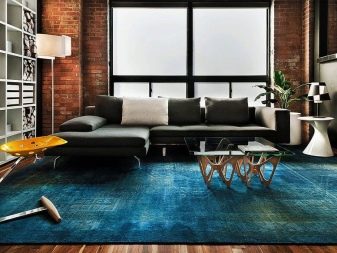
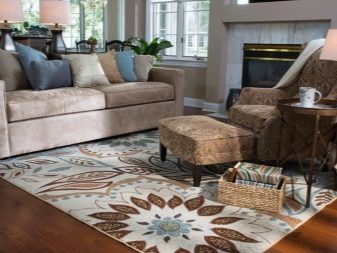
See below for how to choose the right rug.








